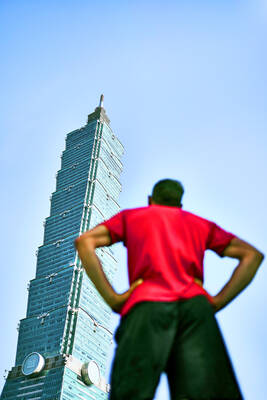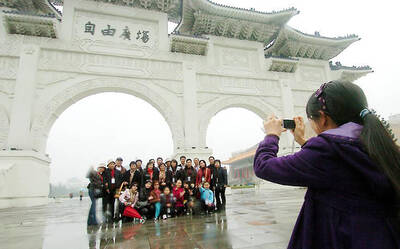The Consumers’ Foundation yesterday called on the government to suspend or lower its planned increase of National Health Insurance (NHI) premiums in light of economic woes felt in the wake of the COVID-19 pandemic.
The National Health Insurance Administration (NHIA) is considering raising premiums from 4.69 percent to 5.52 or 5.55 percent.
Income for businesses and ordinary people worldwide have taken a beating from the pandemic, the foundation said, urging the government to “feel the suffering of the people” and either freeze or lower the premium hike.

Photo: Lo Chi, Taipei Times
Article 3 of the National Health Insurance Act (全民健保法) stipulates that the government “should at least shoulder 36 percent of the remainder of the annual insurance budget minus promulgated revenues,” foundation deputy director-general Wu Jung-ta (吳榮達) said.
With the NHI’s finances in a sorry state and the end of the pandemic uncertain, the government should show compassion for the challenges people are enduring and bear a larger proportion of health insurance premiums, Wu said.
The government should budget for health expenditures and avoid adding to the burden placed on the NHI by leaving payments up to the agency, he added.
As for expanding revenue channels for the NHI, Wu pointed to Article 76 of the act, which allows for a “social health and welfare surcharge” to be placed on sales of alcohol and tobacco to generate revenue for the NHI reserve fund.
A tobacco surcharge has been implemented for many years, but an equivalent tax on alcohol has not yet been levied, he said.
Wu also recommended that the government consider emulating other nations by imposing a sugar tax, which could raise awareness of the dangers associated with consuming excessive amounts of sugar and provide a significant revenue source for the NHI.
According to the NHI’s estimated budget for next year, if premiums remain unchanged and additional funds are not raised elsewhere, the NHI reserve fund would fall below safe levels by the end of the year.
Officials therefore plan to discuss raising premiums during the NHI Committee meeting on Friday next week.
At this point, as raising premiums for next year appears inevitable, the government should at least consider limiting the premium to 4.91 or 5.17 percent at most, the amount it used to be, Wu added.

US climber Alex Honnold is to attempt to scale Taipei 101 without a rope and harness in a live Netflix special on Jan. 24, the streaming platform announced on Wednesday. Accounting for the time difference, the two-hour broadcast of Honnold’s climb, called Skyscraper Live, is to air on Jan. 23 in the US, Netflix said in a statement. Honnold, 40, was the first person ever to free solo climb the 900m El Capitan rock formation in Yosemite National Park — a feat that was recorded and later made into the 2018 documentary film Free Solo. Netflix previewed Skyscraper Live in October, after videos

Starting on Jan. 1, YouBike riders must have insurance to use the service, and a six-month trial of NT$5 coupons under certain conditions would be implemented to balance bike shortages, a joint statement from transportation departments across Taipei, New Taipei City and Taoyuan announced yesterday. The rental bike system operator said that coupons would be offered to riders to rent bikes from full stations, for riders who take out an electric-assisted bike from a full station, and for riders who return a bike to an empty station. All riders with YouBike accounts are automatically eligible for the program, and each membership account

A classified Pentagon-produced, multiyear assessment — the Overmatch brief — highlighted unreported Chinese capabilities to destroy US military assets and identified US supply chain choke points, painting a disturbing picture of waning US military might, a New York Times editorial published on Monday said. US Secretary of Defense Pete Hegseth’s comments in November last year that “we lose every time” in Pentagon-conducted war games pitting the US against China further highlighted the uncertainty about the US’ capability to intervene in the event of a Chinese invasion of Taiwan. “It shows the Pentagon’s overreliance on expensive, vulnerable weapons as adversaries field cheap, technologically

NUMBERS IMBALANCE: More than 4 million Taiwanese have visited China this year, while only about half a million Chinese have visited here Beijing has yet to respond to Taiwan’s requests for negotiation over matters related to the recovery of cross-strait tourism, the Tourism Administration said yesterday. Taiwan’s tourism authority issued the statement after Chinese-language daily the China Times reported yesterday that the government’s policy of banning group tours to China does not stop Taiwanese from visiting the country. As of October, more than 4.2 million had traveled to China this year, exceeding last year. Beijing estimated the number of Taiwanese tourists in China could reach 4.5 million this year. By contrast, only 500,000 Chinese tourists are expected in Taiwan, the report said. The report